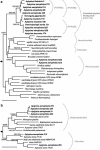Discovery of the novel candidate phylum "Poribacteria" in marine sponges
- PMID: 15184179
- PMCID: PMC427773
- DOI: 10.1128/AEM.70.6.3724-3732.2004
Discovery of the novel candidate phylum "Poribacteria" in marine sponges
Erratum in
- Appl Environ Microbiol. 2006 Aug;72(8):5677
Abstract
Marine sponges (Porifera) harbor large amounts of commensal microbial communities within the sponge mesohyl. We employed 16S rRNA gene library construction using specific PCR primers to provide insights into the phylogenetic identity of an abundant sponge-associated bacterium that is morphologically characterized by the presence of a membrane-bound nucleoid. In this study, we report the presence of a previously unrecognized evolutionary lineage branching deeply in the domain Bacteria that is moderately related to the Planctomycetes, Verrucomicrobia, and Chlamydia lines of decent. Because members of this lineage showed <75% 16S rRNA gene sequence similarity to known bacterial phyla, we suggest the status of a new candidate phylum, named "Poribacteria", to acknowledge the affiliation of the new bacterium with sponges. The affiliation of the morphologically conspicuous sponge bacterium with the novel phylogenetic lineage was confirmed by fluorescence in situ hybridization with newly designed probes targeting different sites of the poribacterial 16S rRNA. Consistent with electron microscopic observations of cell compartmentalization, the fluorescence signals appeared in a ring-shaped manner. PCR screening with "Poribacteria"-specific primers gave positive results for several other sponge species, while samples taken from the environment (seawater, sediments, and a filter-feeding tunicate) were PCR negative. In addition to a report for Planctomycetes, this is the second report of cell compartmentalization, a feature that was considered exclusive to the eukaryotic domain, in prokaryotes.
Figures



References
-
- Althoff, K., C. Schütt, R. Steffen, R. Batel, and W. E. G. Müller. 1998. Evidence for a symbiosis between bacteria of the genus Rhodobacter and the marine sponge Halichondria panicea: harbor also for putatively toxic bacteria? Mar. Biol. 130:529-536.
-
- Bergquist, P. R. 1978. Sponges. University of California Press, Berkeley, Calif.
-
- Böhm, M., H. C. Schroder, I. M. Muller, W. E. Muller, and V. Gamulin. 2000. The mitogen-activated protein kinase p38 pathway is conserved in metazoans: cloning and activation of p38 of the SAPK2 subfamily from the sponge Suberites domuncula. Biol. Cell 92:95-104. - PubMed
-
- Brusca, R. C., and G. J. Brusca. 1990. Phylum Porifera: the sponges, p. 181-210. In A. D. Sinauer (ed.), Invertebrates. Sinauer Press, Sunderland, Mass.
Publication types
MeSH terms
Substances
Associated data
- Actions
- Actions
- Actions
- Actions
- Actions
- Actions
- Actions
- Actions
- Actions
- Actions
- Actions
- Actions
- Actions
- Actions
- Actions
- Actions
- Actions
- Actions
- Actions
- Actions
LinkOut - more resources
Full Text Sources
Other Literature Sources
Molecular Biology Databases

